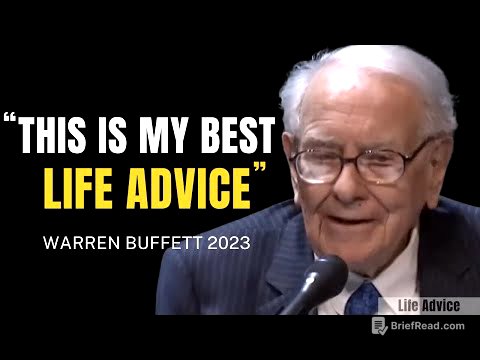TLDR;
Rabbi David introduces the Sacred Morning Method, a six-component practice rooted in Torah wisdom and modern neuroscience, designed to transform lives by commanding the morning before the world does. This method focuses on creating identity, clarity, and momentum, which are essential for building wealth and achieving success. The six components are: Silence and Stillness, Affirmations and Declarations, Capture Your Thoughts (Writing), Read Something Elevating, Exercise and Movement, and Declare Gratitude.
- The practice aims to shift individuals from a reactive to a proactive state, enabling them to create their day and build wealth.
- Consistency, rather than intensity or perfection, is emphasized as the key to transformation.
Introduction: The Power of Commanding Your Morning [0:00]
Rabbi David introduces a morning practice that he claims transformed his life from a struggling accountant to a multi-millionaire, a practice shared by many wealthy individuals and rooted in 3,000 years of Torah teaching. He asserts that dedicating just 10 minutes each morning to this practice can completely alter one's life trajectory. The core idea is to command your morning before the world commands you, emphasizing the importance of taking control of your thoughts and intentions at the start of the day.
The Sacred Window of Morning [1:18]
The period after waking up is described as a sacred window, a time when the mind is open and impressionable, before the chaos and demands of the world intrude. During this time, individuals have the power to choose whether to command their thoughts or be commanded by external influences. Successful individuals use this time to reach within themselves, setting the foundation for wealth, success, and abundance.
The Sacred Morning Method: Six Components [4:04]
Rabbi David introduces the Sacred Morning Method, which includes six critical components: Silence and Stillness, Affirmations and Declarations, Capture Your Thoughts (Writing), Read Something Elevating, Exercise and Movement, and Declare Gratitude. Each component is rooted in Torah wisdom and designed to create a powerful start to the day.
Silence and Stillness [4:18]
The first component involves sitting in silence for five minutes upon waking, without checking phones or reacting to the world. This stillness allows individuals to connect with their inner selves, hear wisdom, and remember their purpose and identity, which can be forgotten in the noise of daily life. This practice resets consciousness and creates space for clarity.
Affirmations and Declarations [6:11]
After silence, the next step is to speak affirmations and declarations to oneself, affirming one's identity, future, and creations with faith. Drawing from Genesis, the Rabbi explains that words have the power to shape reality and determine destiny. It's about embodying these declarations, programming the subconscious, and aligning consciousness with abundance.
Capture Your Thoughts: Writing [8:07]
The third component involves writing down thoughts, ideas, goals, gratitudes, fears, and plans to create vision and clarity. Writing helps to control the mind's flow of thoughts, turning them into tangible form. Rabbi David recommends writing three goals for the day, three things to be grateful for, and one insight or lesson learned.
Read Something Elevating [10:00]
Following writing, the method suggests reading something that elevates, inspires, and reminds one of their aspirations, avoiding news or social media. The aim is to fill the mind with wisdom rather than noise, guarding the heart (mind) by controlling what enters it. This practice shapes thinking for the entire day.
Exercise and Movement [11:31]
The fifth component involves moving the body through walking, stretching, or any activity that gets the blood flowing. This is because physiology influences psychology; energized bodies lead to powerful minds. Movement creates emotion, wakes up the inner warrior, activates energy, and builds momentum, which is crucial for wealth building.
Declare Gratitude [13:08]
The final component is expressing gratitude for what one has, what's coming, and who one is becoming. This gratitude should be real and deep, shifting one's focus from lack to abundance. Gratitude centers and grounds, reminding individuals that they are starting from a place of abundance, which changes their energy and frequency for the entire day.
Why This Works: Identity, Clarity, and Momentum [15:05]
The morning practice works because it creates identity, clarity, and momentum, which are critical for creating wealth. It helps individuals become the kind of person who naturally creates and holds wealth, clarifies their vision and direction, and builds momentum through consistent, small actions.
Success Stories [17:17]
Rabbi David shares three stories of individuals who transformed their lives by implementing the morning practice. Michael, a struggling entrepreneur, doubled his business revenue and halved his stress. Sara, a corporate employee, achieved financial independence and seven-figure income through a side business. David, burdened by massive debt, became debt-free and built savings.
The 30-Day Challenge [22:24]
Rabbi David challenges viewers to commit to the morning practice for 30 days without exceptions or excuses. He emphasizes that these 29 minutes will determine the other 98% of the day, setting the tone, creating momentum, and shaping identity.
Addressing the "No Time" Objection [25:15]
Addressing the common objection of not having enough time, Rabbi David argues that individuals cannot afford not to do this practice. He points out the time wasted on social media and other unproductive activities, stating that making time for this practice is a matter of priority. He insists that if you don't have 30 minutes for yourself in the morning, you don't own your life.
Consistency is Key [28:03]
Rabbi David advises doing the practice in the same place at the same time every day to create a ritual and leverage the power of consistency. Consistency, rather than intensity or perfection, is the key to transformation. He encourages viewers to do the practice consistently, even if it's shortened or imperfect.









![[자막뉴스] 끝내 종지부?...'일어서는 사자'로 본인이 일어선 네타냐후 / YTN](https://wm-img.halpindev.com/p-briefread_c-10_b-10/urlb/aHR0cDovL2ltZy55b3V0dWJlLmNvbS92aS9yWm82UlF4Szg0SS9ocWRlZmF1bHQuanBn.jpg)